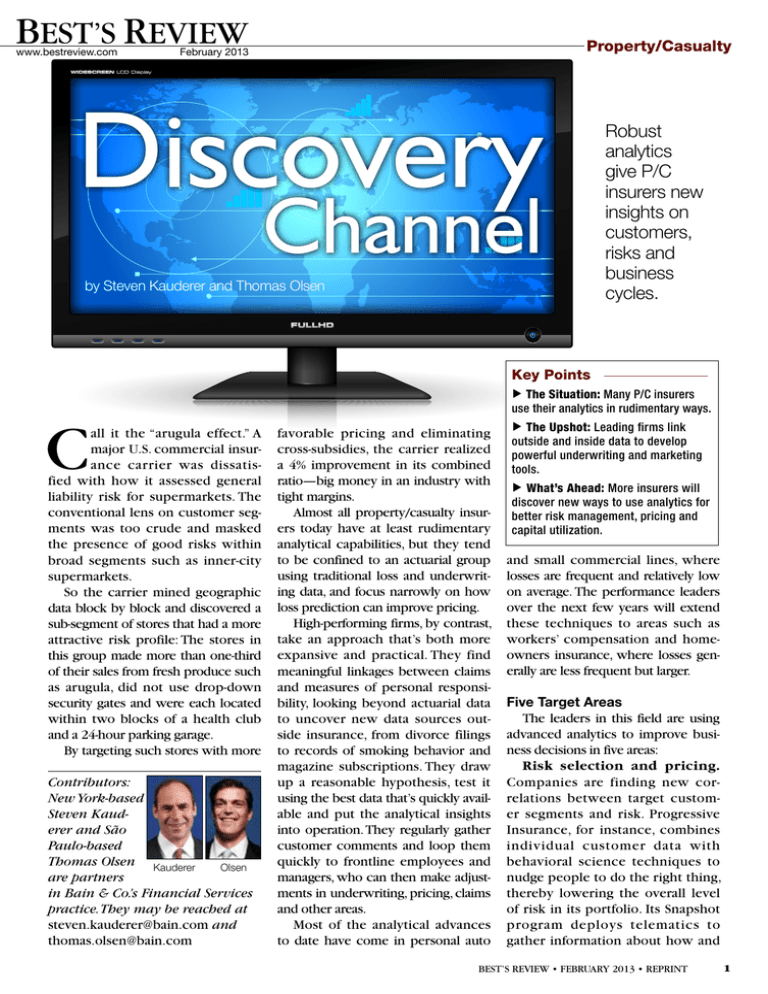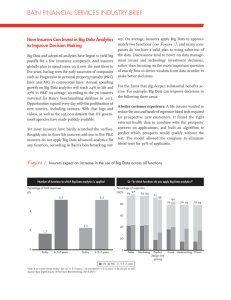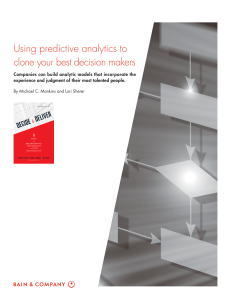
BEST’S REVIEW
www.bestreview.com
Property/Casualty
February 2013
Discovery
Channel
by Steven Kauderer and Thomas Olsen
Robust
analytics
give P/C
insurers new
insights on
customers,
risks and
business
cycles.
Key Points
▼
The Situation: Many P/C insurers
use their analytics in rudimentary ways.
Contributors:
New York-based
Steven Kauderer and São
Paulo-based
Thomas Olsen Kauderer
Olsen
are partners
in Bain & Co.’s Financial Services
practice. They may be reached at
steven.kauderer@bain.com and
thomas.olsen@bain.com
The Upshot: Leading firms link
outside and inside data to develop
powerful underwriting and marketing
tools.
▼
favorable pricing and eliminating
cross-subsidies, the carrier realized
a 4% improvement in its combined
ratio—big money in an industry with
tight margins.
Almost all property/casualty insurers today have at least rudimentary
analytical capabilities, but they tend
to be confined to an actuarial group
using traditional loss and underwriting data, and focus narrowly on how
loss prediction can improve pricing.
High-performing firms, by contrast,
take an approach that’s both more
expansive and practical. They find
meaningful linkages between claims
and measures of personal responsibility, looking beyond actuarial data
to uncover new data sources outside insurance, from divorce filings
to records of smoking behavior and
magazine subscriptions. They draw
up a reasonable hypothesis, test it
using the best data that’s quickly available and put the analytical insights
into operation. They regularly gather
customer comments and loop them
quickly to frontline employees and
managers, who can then make adjustments in underwriting, pricing, claims
and other areas.
Most of the analytical advances
to date have come in personal auto
What’s Ahead: More insurers will
discover new ways to use analytics for
better risk management, pricing and
capital utilization.
▼
C
all it the “arugula effect.” A
major U.S. commercial insurance carrier was dissatisfied with how it assessed general
liability risk for supermarkets. The
conventional lens on customer segments was too crude and masked
the presence of good risks within
broad segments such as inner-city
supermarkets.
So the carrier mined geographic
data block by block and discovered a
sub-segment of stores that had a more
attractive risk profile: The stores in
this group made more than one-third
of their sales from fresh produce such
as arugula, did not use drop-down
security gates and were each located
within two blocks of a health club
and a 24-hour parking garage.
By targeting such stores with more
and small commercial lines, where
losses are frequent and relatively low
on average. The performance leaders
over the next few years will extend
these techniques to areas such as
workers’ compensation and homeowners insurance, where losses generally are less frequent but larger.
Five Target Areas
The leaders in this field are using
advanced analytics to improve business decisions in five areas:
Risk selection and pricing.
Companies are finding new correlations between target customer segments and risk. Progressive
Insurance, for instance, combines
individual customer data with
behavioral science techniques to
nudge people to do the right thing,
thereby lowering the overall level
of risk in its portfolio. Its Snapshot
program deploys telematics to
gather information about how and
Best’s Review • february 2013 • Reprint
1
how much an individual drives in
order to target discounts accurately
at careful drivers and charge more
spirited drivers an appropriate higher
premium.
Analytics can improve the profitability of a carrier’s customer mix
through a robust adverse selection
strategy: actively targeting high-profit
potential customers with attractive
pricing; and by repricing the existing book, driving the worst risks to
competitors.
Customer loyalty and advocacy.
A different type of data is being used
by some P/C insurers to raise the
level of advocacy among customers. They track how customers perceive the company and its products,
sorting customers as promoters,
passives, or detractors to produce
a net score that monitors the quality of customer relationships. Based
on customer feedback, they make
changes to processes that influence
the customer experience.
The business payoffs from customer advocacy are substantial: Bain
estimates that the lifetime profit from
a new policyholder in auto insurance
averages $537 for a promoter, more
than five times the $100 profit for an
average detractor.
The incremental value stems mostly
from greater retention plus word-ofmouth recommendations and a minor
boost from cross-selling opportunities. (See Figure 1.)
Brazil-based Porto Seguro has consistently ranked first in customer loyalty among auto insurers in that market. The company has used analysis of
customer feedback to improve frontline customer service and to create
innovative offerings that both delight
customers and improve the company’s economics.
For instance, Porto Seguro offers
policyholders free mechanical checkups, which improve safety. Before
third brake lights were the industry standard, the company offered
them free to customers as a way
to reduce loss ratios. It determined
that customer discounts for parking
garages, to discourage parking on the
street, positively affected both loyalty
and loss ratios. The company also
offers free locksmith, plumbing and
electrician services to propel sales
of a residential assistance package
added to auto insurance.
High customer loyalty, and the
astute use of customer feedback to
craft new offerings, have contributed
to Porto Seguro’s strong performance
relative to competitors in revenue
growth, loss ratios and return on capital over the past five years.
Claims management. How a
carrier interacts with customers to
handle claims stands as a key moment
of truth. Among certain P/C lines, Bain
& Co. has found that claims management is the area with the greatest
potential to annoy or delight customers. (See Figure 2.)
Analytics can help strengthen
claims management by devising
smarter segmentation of customers
and their predicted behavior (through
latent class-regression modeling) and
more accurate prediction of the likelihood and timing of relevant events
(through hazard modeling). These
scientific methods raise one’s confidence about the projected frequency
and amount of claims. They’re increasingly relevant as one moves to more
complex types of claims.
Figure 1
Happy Campers
Satisfied insurance customers renew and recommend at higher rates than dissatisfied clients.
Renewal ratio at last renewal
Likely* to buy another product from
your current motor/home insurer
Actually recommended in
last 12 months
80%
80%
80%
72%
68%
63%
63%
60
60
60
53%
40
40
20
20
40%
40
37%
20
10%
9%
0
Promoters
Passives
Detractors
0
Promoters
Passives
Detractors
*Rating of 7 to 10 out of 10
Source: Bain/Research Now UK Motor and Home Insurance NPS Survey, October/November 2010 (n=4,936)
2
Best’s Review • february 2013 • Reprint
0
Promoters
Passives
Detractors
Property/Casualty
Equally important is how well
customers are managed through the
claims process. Some leading companies are giving customers a greater
role in the process, such as encouraging drivers to shoot photographs of
their auto accidents on their smartphones and to email those pictures
from the scene.
Management of business
cycles. Some carriers capitalize early
on cycle-driven opportunities. They
use analytics to identify niche markets that buck the general trend, or
they anticipate and act on turns in the
cycle sooner than competitors do. In
personal home insurance lines, one
region might continue to have a hard
market while other regions’ markets
are softening.
W.R. Berkley, one of the largest
underwriters of commercial insurance, is also one of the most flexible
because of how it manages cycles.
Berkley allows each of its dozens
of subsidiaries in the United States
and abroad to make pricing decisions and respond quickly to local
customer needs, within preset risk
parameters. That decentralized
approach makes Berkley more
nimble than competitors that centralize pricing, helping it to expand
across geographies and niche specialty segments such as life sciences.
Over the past decade, Berkley has
been among the most consistent outperformers in its combined ratio and
growth in direct premiums written.
Capital efficiency. Analytics also
can be a powerful tool in the CFO’s
arsenal to better manage capital.
This dynamic plays out in a couple
of ways. Analytics can strengthen
customer loyalty, as discussed earlier, which reduces customer lapses
(churn) and volatility; in turn, that
lowers economic capital requirements and therefore raises the return
on capital. Estimates by Bain and Towers Watson for one European insurer
showed a 1% reduction in internally
modeled solvency capital requirements with a 10% reduction in the
volatility of lapses.
In addition, analytics helps executives determine the likelihood of different risk scenarios for a line of business.
Analysis, say, of a concentration of real
estate coverage in a particular region
will reveal whether that region’s
claims are more volatile, or less, than
others, and whether it correlates with
losses in other regions and so on.
Products and segments with the
same combined ratio can have different returns on risk-adjusted capital, given the characteristics of the
risks and the insurer’s portfolio. ITAU,
the leading P/C insurer in Brazil, uses
return on risk-adjusted capital as a
competitive advantage, the company notes in a 2011 Securities and
Exchange Commission filing, because
that gives it a more precise measure
of risk versus return and capital allocation. Other companies that choose
to rely on simpler metrics, such as
combined ratios, might end up on the
wrong side of adverse selection.
By advancing in each of the five
areas, carriers can expect to improve
their combined ratio by 3% to 5%
and their annual revenue growth by
5% to 15%. The leaders will have a
head start as data continues to pour
into the industry. Moreover, advanced
analytics will only grow more useful
as the volume and types of data continue to proliferate in the future. BR
Figure 2
Make or Break
Claims management is the biggest reason why insurers please or displease their customers.
High
Critical for
promoter
creation
Policy
renewal
Advice
and
quotation
Claims
management
Information
request and
first contacts
Potential to delight
Policy
adjustments
Low
Policy
issue
Critical for detractor avoidance
Low
High
Potential to anger
Source: Bain & Co. client example
Best’s Review • february 2013 • Reprint
Copyright © 2013 by A.M. Best Company, Inc. All Rights Reserved. Reprinted with Permission. www.ambest.com
3












